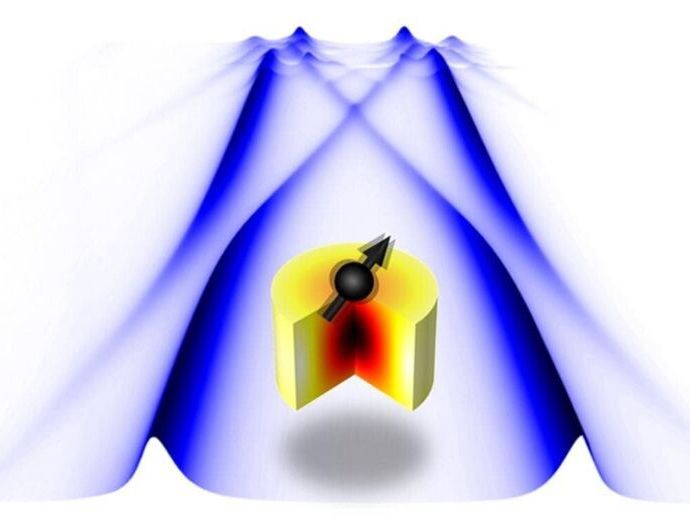Archive for the ‘quantum physics’ category: Page 488
Jan 15, 2021
The Cybernetic Singularity: The Syntellect Emergence
Posted by Alex Vikoulov in categories: life extension, quantum physics, robotics/AI, singularity
“By contemplating the full spectrum of scenarios of the coming technological singularities, many can place their bets in favor of the Cybernetic Singularity which is the surest path to cybernetic immortality and engineered godhood as opposed to the AI Singularity when Homo sapiens is hastily retired as a senescent parent. This meta-system transition from the networked Global Brain to the Gaian Mind is all about evolution of our own individual minds; it’s all about our own Self-Transcendence.”-Alex M. Vikoulov, The Cybernetic Singularity: The Syntellect Emergence #CyberneticSingularity #SyntellectEmergence #CyberneticTheoryofMind #AlexMVikoulov #consciousness #phenomenology #evolution #cybernetics #SyntellectHypothesis #PhilosophyofMind #QuantumTheory #PhysicsofTime #PressRelease #NewBookRelease #AmazonKindle #AlexVikoulov #EcstadelicMediaGroup
Ecstadelic Media Group releases a new non-fiction book The Cybernetic Singularity: The Syntellect Emergence, The Cybernetic Theory of Mind series by Alex M. Vikoulov as a Kindle eBook (Press Release, San Francisco, CA, USA, January 102021 08.00 PM PST)
Jan 15, 2021
Physicists Find New State of Matter in a One-Dimensional Quantum Gas – “Beyond My Wildest Conception”
Posted by Genevieve Klien in categories: particle physics, quantum physics
By adding some magnetic flair to an exotic quantum experiment, physicists produced an ultra-stable one-dimensional quantum gas with never-before-seen “scar” states – a feature that could someday be useful for securing quantum information.
As the story goes, the Greek mathematician and tinkerer Archimedes came across an invention while traveling through ancient Egypt that would later bear his name. It was a machine consisting of a screw housed inside a hollow tube that trapped and drew water upon rotation. Now, researchers led by Stanford University physicist Benjamin Lev have developed a quantum version of Archimedes’ screw that, instead of water, hauls fragile collections of gas atoms to higher and higher energy states without collapsing. Their discovery is detailed in a paper published today (January 142021) in Science.
Jan 15, 2021
Important Milestone in the Creation of a Quantum Computer That Uses Transistors As Qubits
Posted by Quinn Sena in categories: computing, mobile phones, quantum physics
One of the obstacles for progress in the quest for a working quantum computer has been that the working devices that go into a quantum computer and perform the actual calculations, the qubits, have hitherto been made by universities and in small numbers. But in recent years, a pan-European collaboration, in partnership with French microelectronics leader CEA-Leti, has been exploring everyday transistors — that are present in billions in all our mobile phones — for their use as qubits.
The French company Leti makes giant wafers full of devices, and, after measuring, researchers at the Niels Bohr Institute, University of Copenhagen, have found these industrially produced devices to be suitable as a qubit platform capable of moving to the second dimension, a significant step for a working quantum computer. The result is now published in Nature Communications.
One of the key features of the devices is the two-dimensional array of quantum dot. Or more precisely, a two by two lattice of quantum dots. “What we have shown is that we can realize single electron control in every single one of these quantum dots. This is very important for the development of a qubit, because one of the possible ways of making qubits is to use the spin of a single electron. So reaching this goal of controlling the single electrons and doing it in a 2D array of quantum dots was very important for us,” says Fabio Ansaloni, former PhD student, now postdoc at center for Quantum Devices, NBI.
Jan 14, 2021
First Nanomaterial Developed That Demonstrates “Photon Avalanching” – Extreme Nonlinear Optical Behavior and Efficiency
Posted by Genevieve Klien in categories: biotech/medical, chemistry, engineering, nanotechnology, quantum physics
Researchers develop the first nanomaterial that demonstrates “photon avalanching;” finding could lead to new applications in sensing, imaging, and light detection.
Researchers at Columbia Engineering report today that they have developed the first nanomaterial that demonstrates “photon avalanching,” a process that is unrivaled in its combination of extreme nonlinear optical behavior and efficiency. The realization of photon avalanching in nanoparticle form opens up a host of sought-after applications, from real-time super-resolution optical microscopy, precise temperature and environmental sensing, and infrared light detection, to optical analog-to-digital conversion and quantum sensing.
“Nobody has seen avalanching behavior like this in nanomaterials before,” said James Schuck, associate professor of mechanical engineering, who led the study published today (January 132021) by Nature. “We studied these new nanoparticles at the single-nanoparticle level, allowing us to prove that avalanching behavior can occur in nanomaterials. This exquisite sensitivity could be incredibly transformative. For instance, imagine if we could sense changes in our chemical surroundings, like variations in or the actual presence of molecular species. We might even be able to detect coronavirus and other diseases.”
Jan 14, 2021
New state of matter in one-dimensional quantum gas
Posted by Saúl Morales Rodriguéz in categories: particle physics, quantum physics
As the story goes, the Greek mathematician and tinkerer Archimedes came across an invention while traveling through ancient Egypt that would later bear his name. It was a machine consisting of a screw housed inside a hollow tube that trapped and drew water upon rotation. Now, researchers led by Stanford University physicist Benjamin Lev have developed a quantum version of Archimedes’ screw that, instead of water, hauls fragile collections of gas atoms to higher and higher energy states without collapsing. Their discovery is detailed in a paper published Jan. 14 in Science.
“My expectation for our system was that the stability of the gas would only shift a little,” said Lev, who is an associate professor of applied physics and of physics in the School of Humanities and Sciences at Stanford. “I did not expect that I would see a dramatic, complete stabilization of it. That was beyond my wildest conception.”
Along the way, the researchers also observed the development of scar states—extremely rare trajectories of particles in an otherwise chaotic quantum system in which the particles repeatedly retrace their steps like tracks overlapping in the woods. Scar states are of particular interest because they may offer a protected refuge for information encoded in a quantum system. The existence of scar states within a quantum system with many interacting particles—known as a quantum many-body system—has only recently been confirmed. The Stanford experiment is the first example of the scar state in a many-body quantum gas and only the second ever real-world sighting of the phenomenon.
Jan 13, 2021
The New Techno-Fusion: The Merging Of Technologies Impacting Our Future
Posted by Chuck Brooks in categories: augmented reality, biotech/medical, economics, health, internet, media & arts, quantum physics, robotics/AI, virtual reality
The process of systems integration (SI) functionally links together infrastructure, computing systems, and applications. SI can allow for economies of scale, streamlined manufacturing, and better efficiency and innovation through combined research and development.
New to the systems integration toolbox are the emergence of transformative technologies and, especially, the growing capability to integrate functions due to exponential advances in computing, data analytics, and material science. These new capabilities are already having a significant impact on creating our future destinies.
The systems integration process has served us well and will continue to do so. But it needs augmenting. We are on the cusp of scientific discovery that often combines the physical with the digital—the Techno-Fusion or merging of technologies. Like Techno-Fusion in music, Techno-Fusion in technologies is really a trend that experiments and transcends traditional ways of integration. Among many, there are five grouping areas that I consider good examples to highlight the changing paradigm. They are: Smart Cities and the Internet of Things (IoT); Artificial Intelligence (AI), Machine Learning (ML), Quantum and Super Computing, and Robotics; Augmented Reality (AR) and Virtual Reality Technologies (VR); Health, Medicine, and Life Sciences Technologies; and Advanced Imaging Science.
Jan 13, 2021
Engineers observe avalanches in nanoparticles for the first time
Posted by Saúl Morales Rodriguéz in categories: biotech/medical, chemistry, engineering, finance, nanotechnology, quantum physics
Researchers at Columbia Engineering report today that they have developed the first nanomaterial that demonstrates “photon avalanching,” a process that is unrivaled in its combination of extreme nonlinear optical behavior and efficiency. The realization of photon avalanching in nanoparticle form opens up a host of sought-after applications, from real-time super-resolution optical microscopy, precise temperature and environmental sensing, and infrared light detection, to optical analog-to-digital conversion and quantum sensing.
“Nobody has seen avalanching behavior like this in nanomaterials before,” said James Schuck, associate professor of mechanical engineering, who led the study published today by Nature. “We studied these new nanoparticles at the single-nanoparticle level, allowing us to prove that avalanching behavior can occur in nanomaterials. This exquisite sensitivity could be incredibly transformative. For instance, imagine if we could sense changes in our chemical surroundings, like variations in or the actual presence of molecular species. We might even be able to detect coronavirus and other diseases.”
Avalanching processes—where a cascade of events is triggered by series of small perturbations—are found in a wide range of phenomena beyond snow slides, including the popping of champagne bubbles, nuclear explosions, lasing, neuronal networking, and even financial crises. Avalanching is an extreme example of a nonlinear process, in which a change in input or excitation leads to a disproportionate—often disproportionately large—change in output signal. Large volumes of material are usually required for the efficient generation of nonlinear optical signals, and this had also been the case for photon avalanching, until now.
Jan 13, 2021
Pivotal discovery in quantum and classical information processing
Posted by Saúl Morales Rodriguéz in categories: engineering, particle physics, quantum physics
Working with theorists in the University of Chicago’s Pritzker School of Molecular Engineering, researchers in the U.S. Department of Energy’s (DOE) Argonne National Laboratory have achieved a scientific control that is a first of its kind. They demonstrated a novel approach that allows real-time control of the interactions between microwave photons and magnons, potentially leading to advances in electronic devices and quantum signal processing.
Microwave photons are elementary particles forming the electromagnetic waves that we use for wireless communications. On the other hand, magnons are the elementary particles forming what scientists call “spin waves”—wave-like disturbances in an ordered array of microscopic aligned spins that can occur in certain magnetic materials.
Microwave photon-magnon interaction has emerged in recent years as a promising platform for both classical and quantum information processing. Yet, this interaction had proved impossible to manipulate in real time, until now.
Jan 13, 2021
Physicists Detect Tantalising Hints of a “Fundamentally New Form of Quantum Matter”
Posted by Paul Battista in categories: particle physics, quantum physics
Metals and insulators are the yin and yang of physics, their respective material properties strictly dictated by their electrons’ mobility — metals should conduct electrons freely, while insulators keep them in place.
So when physicists from Princeton University in the US found a quantum quirk of metals bouncing around inside an insulating compound, they were lost for an explanation.
We’ll need to wait on further studies to find out exactly what’s going on. But one tantalising possibility is that a previously unseen particle is at work, one that represents neutral ground in electron behaviour. They’re calling it a ‘neutral fermion’.


















